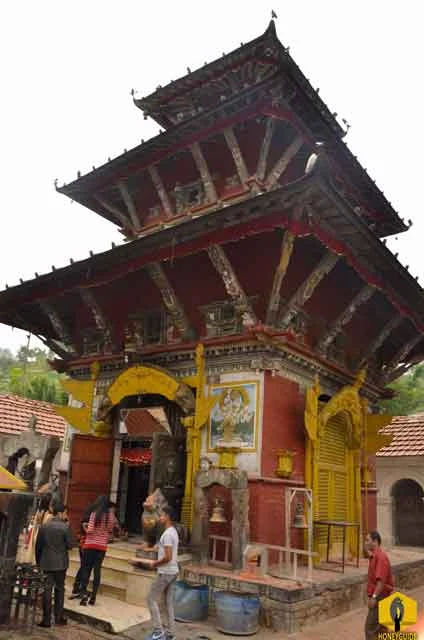Jal Binayak area has taken its name from the temple of Jal Ganesh it incorporates and covers Jal Binayak Temple, Chobhar Hill and Chobhar gorge. The stone image of Ganesh located in the area is believed to have emerged out of water. So the idol was named Jal Binayak meaning the Ganesh which evolved out of water and the whole area got renowned with the same name. The temple is also popular as Koyena Ganesh among Newars.
Historical Facts suggest the temple was built in 723 Nepal Sambat by King Shiva Singh Malla, Gold plated Gajur was added to the roof in 789 Nepal Sambat by King Sri Nivas Malla of Patan and reconstructed in Pagoda Style in 871 Nepal Sambat by King Rajya Prakash Malla of Kathmandu in 871 Nepal Sambat.
Chobar gorge behind the temple is a popular destination, and very much a part of the folklore. There is geographical evidence that supports the notion that Kathmandu valley was once a huge lake. Manjushree, an avatar of Saraswati, the Goddess of Wisdom, cut the gorge open to drain the lake. All the rivers and lakes of the Kathmandu valley are believed to exit the valley via Chobar. Some stories also mention how a very powerful nag (snake) who inhabited the lake almost escaped when Manjushree cut open the gorge to drain the water. Snakes are considered very auspicious in Nepali culture and are believed to be closely associated with rainfall. To prevent the drought that would surely occur if the snake escaped, Jal Vinayak, an avatar of Lord Ganesh, showed Manjushree where another smaller lake in the valley could be made for the nag to dwell. Thus, the residents of the valley would not have to go without rain. There is, indeed, a lake nearby called Taudaha, which fits such a description. Tau in Newari means gigantic and daha in Nepali means lake, hence the name Taudaha for ‘a huge lake’ (though Taudaha is not so ‘huge’).
The image of Ganesh found at Jal Vinayak is very different from the usual images of Ganesh found in numerous other Ganesh temples around the city. The image within the ancient temple is an impression on a large rock that resembles an elephant’s head. The elephant’s head on the human body is, of course, how we recognize Ganesh, as distinct from the images of other gods and goddesses. The name Jal Vinayak comes from Nepali jal, ‘water’, and vinayak is another name for Lord Ganesh.
In Nepal’s customary puja ceremonies, Ganesh is always worshipped first, before any other deities, and as Tuesdays are believed to be propitious for worshipping Ganesh the Jal Vinayak temple is particularly crowded that day each week. One occasion for such worship is the celebration of Anna Prashan, the feeding of an infant his or her first grain of rice. It has also been a common belief amongst the Nepalese that Lord Ganesh has the power to find a groom for an unmarried girl and to bless people with children. Hence, a large number of devotees pray at the Jal Vinayak to experience the joy of matrimony and/or parenthood. There is also a huge flat stone inside the temple premises. It is believed that if you lay down on it, it will cure a backache. It is not uncommon to see people being helped to lay flat on their backs on the stone, hoping to ease back pains. Besides Jal Vinayak, there are also Ashok Vinayak, Karya Vinayak, Surya Vinayak and Kamal Vinayak, each of whom are also avatars of Lord Ganesh. Each one has its own special power that brings devotees flocking to their temples located around the valley.
Chobar’s Jal Vinayak temple is very scenic next to the river running through the Chobar hills. The soothing gush of the water flowing between the cliffs of the gorge is hard to miss. A river typically signifies a journey and the river bank behind the temple is also used as a site where Hindus cremate their dead, sending them on their final journey.
A visit to Jal Vinayak temple to be blessed with children, or find a groom, or cure a nagging backache, or just to be near a part of popular Nepali mythology is quite worth it. To get there, take a bus or taxi from Balkhu, a mere ten minute drive from Basantapur Durbar Square, for a fifteen minute ride to the temple. Or walk... or bike... and enjoy the outing and the significance of this picturesque religious shrine.








0 Comments